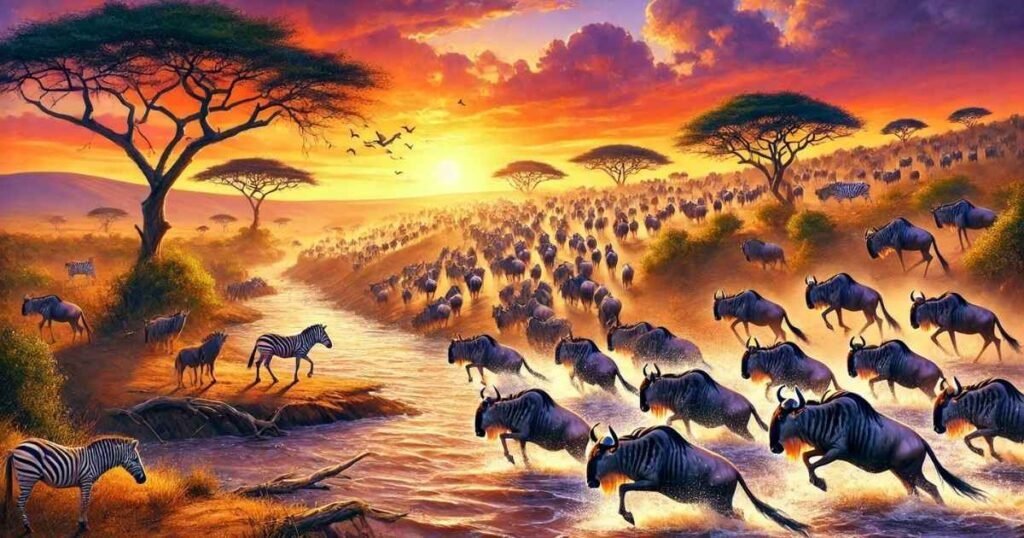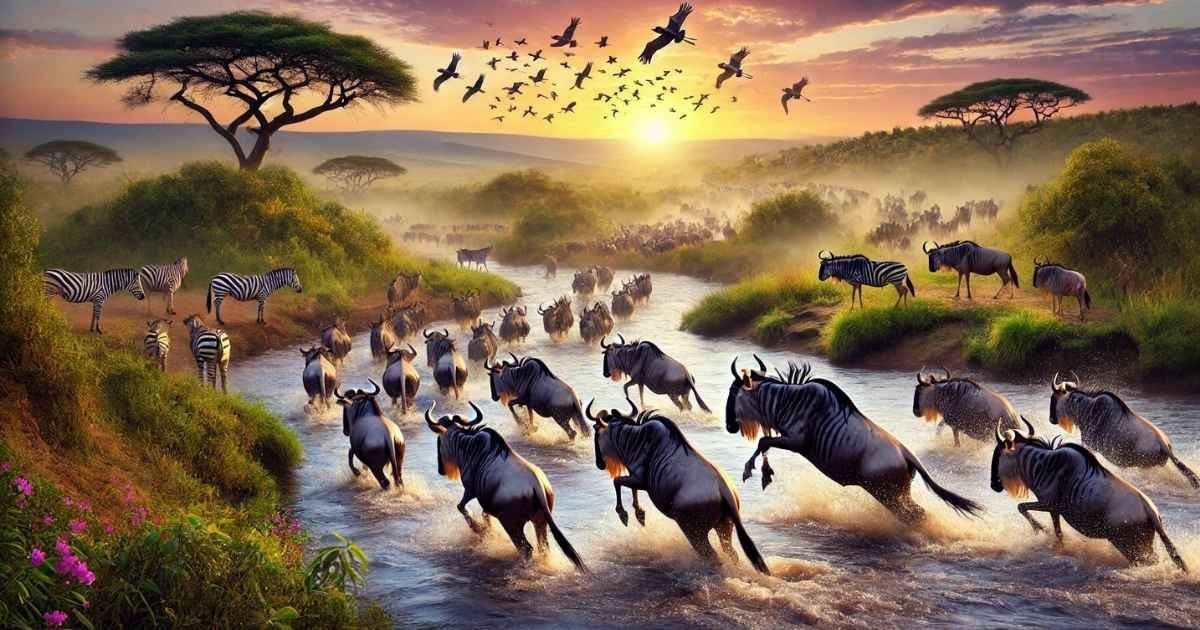Introduction
The Wildebeest Migration, often described as the Great Migration, is a breathtaking natural phenomenon that captures the essence of Africa’s untamed wilderness. It is one of the largest animal migrations in the world, involving the movement of over 1.5 million wildebeests, accompanied by 200,000 zebras and hundreds of thousands of gazelles. Together, they traverse the Serengeti-Mara ecosystem in a relentless quest for survival, fresh grazing lands, and water.
What makes this migration extraordinary is its sheer scale and dramatic encounters with predators, river crossings, and harsh environmental challenges. The migration route spans over 1,800 miles, crossing the borders of Tanzania and Kenya, making it a truly international spectacle of nature. From January to December, this cyclical journey tells a story of endurance, instinct, and ecological balance.
In this article, we will explore the wonders of the Wildebeest Migration, delving into its geographical route, timeline, ecological importance, and tips for witnessing this awe-inspiring event. Whether you’re a wildlife enthusiast, a traveler, or simply a lover of nature, the Wildebeest Migration offers a profound glimpse into the intricate workings of our planet’s ecosystems.
What Is the Wildebeest Migration?
The Wildebeest Migration is an annual movement of herbivores across the Serengeti-Mara ecosystem, dictated by the rhythm of the seasons. Wildebeests, the primary participants, belong to the antelope family and are uniquely adapted to thrive in East Africa’s grasslands. Their movement is driven by an ancient instinct to follow rainfall patterns, ensuring access to lush, nutrient-rich grass and water.
The migration is more than just a journey for survival; it is a natural spectacle that supports and sustains the Serengeti-Mara ecosystem. Zebras and gazelles accompany the wildebeests, forming a harmonious relationship. Zebras graze on tougher grass, paving the way for wildebeests to feed on the softer grass beneath, while gazelles consume shoots and herbs.
Predators such as lions, cheetahs, leopards, hyenas, and crocodiles follow the herds, ensuring that only the fittest survive. This predator-prey interaction maintains ecological balance and prevents overpopulation. The Wildebeest Migration is not merely a display of numbers but an intricate dance of life, death, and survival that sustains the biodiversity of the region.
The Geography of the Migration
The Wildebeest migration occurs in the Serengeti National Park in Tanzania and the Maasai Mara National Reserve in Kenya. These two iconic landscapes are connected by the migration route and form a seamless habitat for countless wildlife species.
Serengeti National Park in Tanzania
The Serengeti is synonymous with vast, open plains that stretch to the horizon, punctuated by acacia trees and rocky outcrops called kopjes. The southern Serengeti is the starting point for the migration, where the calving season takes place from January to March. This region provides ample grass and water during the rainy season, attracting wildebeests and other grazers.
The Serengeti’s ecosystem is an intricate web of life, with its grasslands supporting vast herds of herbivores and apex predators. The park is a UNESCO World Heritage Site, recognized for its importance in global biodiversity conservation.
Maasai Mara National Reserve in Kenya
To the north of the Serengeti lies the Maasai Mara, a reserve known for its rolling grasslands, acacia-dotted savannas, and dramatic river crossings. The Mara River, a lifeline for the herds, becomes a stage for one of nature’s most thrilling spectacles. Here, wildebeests face their greatest challenge: crossing the crocodile-infested waters while avoiding stampedes and drowning.
The Maasai Mara is named after the Maasai people, who coexist with wildlife in this unique landscape. The reserve is a hotspot for tourists seeking to witness the Wildebeest migration, offering unparalleled opportunities for game viewing and photography.
Timeline of the Wildebeest Migration
The Wildebeest Migration is a year-round event, broken into distinct phases based on the herds’ movements and the challenges they face. Each phase of the Great Migration offers a unique perspective on the migration’s trials and triumphs.
January – March: The Calving Season
During this period, the southern Serengeti comes alive as wildebeests gather to give birth to their young. Nearly 500,000 calves are born within a few weeks, an extraordinary synchronized birthing phenomenon. This tactic overwhelms predators, ensuring that a significant number of calves survive.
The calving season is a time of plenty for predators like lions, cheetahs, and hyenas, which take advantage of the abundance of vulnerable prey. However, the protective instincts of mother wildebeests often lead to dramatic encounters, showcasing the delicate balance between life and death in the wild.
April – June: The Journey Northward
As the rains subside, the herds begin their journey northward. This phase of the migration is marked by long treks across the Serengeti’s plains, where resources become scarce. Wildebeests face challenges such as exhaustion, dehydration, and predation.
The Grumeti River, one of the migration’s key milestones, provides a critical water source but also presents a deadly obstacle. Crocodiles lie in wait, and the weaker members of the herd often fall victim to these aquatic predators.
July – October: The Iconic River Crossings
The Mara River crossings are the migration’s most iconic moments. Thousands of wildebeests crowd along the riverbanks, pausing in anticipation before making the daring leap into the water. Strong currents, crocodiles, and the sheer chaos of stampedes result in significant casualties, but this phase also highlights the herds’ resilience and determination.
The plains of the Maasai Mara provide a temporary haven for the survivors, offering rich grasslands and a reprieve before the journey continues.
November – December: The Return Journey
As rains return to the southern Serengeti, the herds begin their migration back. This phase marks the renewal of the grasslands, which have been rejuvenated by the nutrient-rich droppings left by the herds. The cycle of the Wildebeest Migration begins anew, a testament to nature’s enduring rhythms.
Fascinating Facts About the Wildebeest Migration

The Wildebeest Migration is one of nature’s most extraordinary events, showcasing resilience, survival instincts, and ecological balance. Here are some fascinating facts about Wildebeest Migration:
It’s the Largest Terrestrial Migration on Earth
- Each year, more than 1.5 million wildebeests, joined by 200,000 zebras and hundreds of thousands of gazelles, embark on this epic migration.
- The herds travel a circular route of approximately 1,800 miles, making it the largest overland migration on the planet.
The Migration Follows the Rainfall
- Wildebeests are driven by an ancient instinct to follow seasonal rains in search of fresh grass and water.
- Rainfall patterns dictate the timing and route of the migration, making it a highly dynamic event.
Synchronization of Births
- During the calving season (January to March), around 500,000 calves are born within a few weeks.
- This synchronized birthing overwhelms predators, increasing the survival chances of newborns.
Zebras and Wildebeests Are Perfect Companions
- Zebras and wildebeests often travel together because their grazing habits complement each other.
- Zebras eat the tougher, longer grass, while wildebeests prefer the softer, shorter grass beneath.
River Crossings Are the Most Dangerous Moments
- The Mara River crossings are the migration’s most iconic and perilous events.
- Wildebeests face strong currents, crocodile-infested waters, and the chaos of stampedes.
- Thousands of animals perish in these crossings, but their bodies feed aquatic and terrestrial scavengers, enriching the ecosystem.
It’s a Continuous Journey
- The migration is a year-round cycle with no definitive start or end point.
- As the herds travel in pursuit of food and water, they contribute significantly to sustaining the health and balance of the Serengeti-Mara ecosystem.
Predators Rely on the Migration
- The migration provides a reliable food source for predators like lions, cheetahs, leopards, hyenas, and crocodiles.
- Predators follow the herds, preying on the weak, injured, or young, helping maintain a healthy population of herbivores.
Wildebeests Are Built for Migration
- Wildebeests are highly efficient travelers, capable of covering up to 30 miles in a single day.
- Their strong legs, endurance, and ability to detect rain make them perfectly adapted for their long journey.
The Migration Supports Biodiversity
- Through grazing, trampling, and fertilizing the grasslands, wildebeests play a crucial role in revitalizing vegetation.
- Their movement supports the survival of other species, including insects, birds, and smaller mammals.
It’s a Global Tourism Magnet
- The migration attracts thousands of tourists annually, generating significant revenue for Tanzania and Kenya.
- Safaris centered around the migration offer unforgettable experiences for wildlife enthusiasts and photographers.
Not All Animals Make It
- Around 250,000 wildebeests die during the migration due to predation, exhaustion, drowning, or disease.
- Despite the high mortality rate, the population remains stable because of the high birth rate during the calving season.
The Wildebeest’s “Rain Radar”
- Wildebeests are known for their ability to sense rainfall from miles away.
- This ability helps them navigate toward greener pastures, ensuring their survival.
Must Read : Hyland Hills: Adventures Await in Every Season
Why is the Wildebeest Migration Important?
Ecological Significance
The Great Migration is more than a breathtaking sight; it is a vital pillar of the Serengeti-Mara ecosystem. By grazing on grasslands, wildebeests prevent overgrowth, promote plant diversity, and support the regeneration of vegetation. Their droppings fertilize the soil, ensuring the productivity of the ecosystem for generations to come.
Predators depend on the migration for survival, as it provides a consistent food source. Without the migration, the balance between herbivores and carnivores would be disrupted, leading to ecological instability.
Economic Impact
The Great migration is a major driver of wildlife tourism in East Africa. Millions of tourists visit Tanzania and Kenya annually to witness the migration, generating significant revenue for local communities and conservation efforts. Safari lodges, guides, and transportation services thrive on the influx of visitors, creating jobs and boosting the regional economy.
Challenges Faced During the Migration
The Wildebeest Migration is fraught with challenges that test the endurance and survival of the herds. Rivers like the Mara and Grumeti are formidable barriers, claiming the lives of many wildebeests. Droughts, harsh terrain, and extreme weather conditions further complicate the journey. Predators play a crucial role in the migration, targeting the weak and vulnerable. Lions, cheetahs, leopards, and hyenas are relentless hunters, while crocodiles dominate the river crossings. These predators ensure that only the fittest members of the herd survive, contributing to the genetic health of the population.
Tips for Witnessing the Migration
To experience the Wildebeest Migration firsthand, careful planning is essential.
Best Time to Visit:
July to October for river crossings.
January to March for the calving season.
Top Locations:
Serengeti National Park, Maasai Mara Reserve, Grumeti River, Mara River.
Eco-Tourism:
Choose sustainable safari operators to minimize environmental impact.
Support local conservation initiatives to protect the migration for future generations.
Conclusion
The Wildebeest Migration is a natural masterpiece that epitomizes the beauty and resilience of life on Earth. It stands as a powerful reminder of the interconnectedness of ecosystems and the primal strength of survival instincts. Witnessing this spectacle not only enriches our understanding of nature but also inspires a deeper appreciation for the wonders of our planet.
Whether you plan to visit or simply marvel from afar, the Great Migration is a phenomenon that leaves an indelible mark on the hearts of those who experience it.
Read More : BigBillyMartin: The Legacy of a Baseball Icon
Thanks for visiting globalexpressinfo.com. Don’t forget to share it on Twitter.






